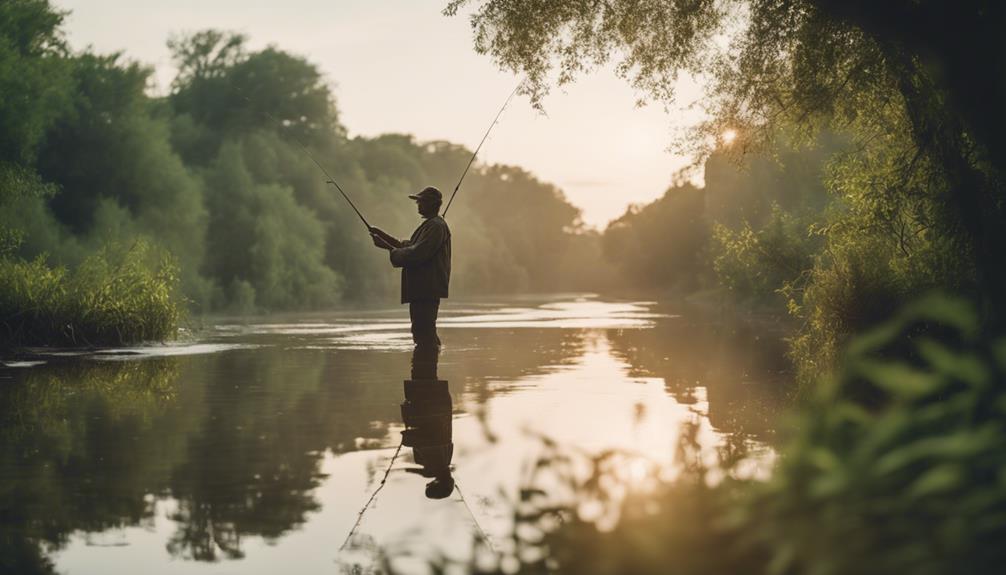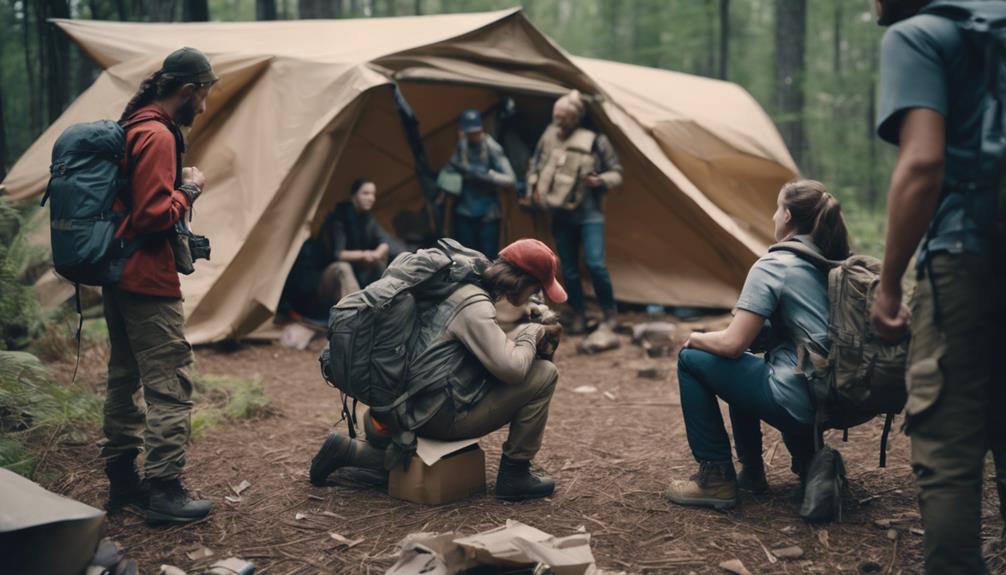Stay connected during emergencies with radios prioritizing durability, portability, and NOAA Weather Radio reception. Opt for models like Yaesu FT-60R or Icom IC-V86 for their ruggedness and transmitting range. Guarantee sustainable power with battery packs, solar panels, or hand cranks. Enhance reception by choosing the right antennas for peak performance. Consider analog Vs. digital radios for sound quality and resistance to interference. For top recommendations, look into Midland ER210 E+READY or C.Crane CC Solar Observer. These radios offer SOS signaling, multiple power sources, and water resistance. Ready for more insights on staying prepared in emergencies?
Key Takeaways
- Prioritize radios with multiple power sources for extended usability.
- Opt for durable and portable radios with water and dust protection.
- Choose radios with reliable battery life and efficient power management.
- Select models with extended transmission range like ham radios.
- Ensure radios receive NOAA Weather Radio and Emergency Alert System for critical updates.
Essential Features for Prepper Radios
When choosing radios for prepping, prioritize essential features like durability and versatility. Look for emergency radios with water and dust protection, making sure they're durable in harsh conditions. These radios should be portable, rugged, and user-friendly for easy use during emergencies.
Essential features to take into account include the reception of NOAA Weather Radio and Emergency Alert System for accurate information dissemination. It's vital to opt for radios with a transmitting radius of at least a few miles to guarantee effective communication in emergency situations.
Additionally, the best prepper radios offer versatile access to various frequencies, such as first responder, aviation, and marine channels. By emphasizing these key features in your selection process, you can ensure that your prepper radio is reliable and ready to keep you connected when it matters most.
Choosing the Right Radio Type

When selecting the right radio type for your prepping needs, you must consider important factors like:
- Radio range
- Power sources
- Portability and durability
These elements determine the effectiveness of communication in emergency situations, ensuring you stay connected when it matters most.
Make informed decisions based on these key points to enhance your preparedness strategy.
Radio Range Considerations
Understanding the importance of radio range considerations is essential for selecting the most suitable radio type for your prepping needs. Ham radio operators benefit from a transmission range that out-distances CB and FRS radios, allowing for interactive communication over longer distances.
These radios can transmit on various frequencies like FRS, MURS, and GMRS, utilizing propagation primarily by line of sight. While most transmissions occur within a few miles, some ham radios have the capability to reach globally using HF frequencies, making them valuable tools for emergency radios.
When choosing a radio for your prepping kit, the ability to maintain communication over longer distances is vital. By taking into account radio range considerations, you make sure that your communication needs are met, especially in times of crisis.
Ham radios stand out for their extended transmission range, enabling reliable interactive communication even when traditional means may fail.
Power Source Options
Radio range considerations play a significant role in determining the appropriate power source options when choosing the right radio type for your prepping needs. To guarantee you stay connected in emergencies, consider these power source options for your emergency radios:
- Emergency radios with multiple power sources like battery packs, solar panels, and hand cranks provide versatile charging options.
- Opt for radios with rechargeable batteries to avoid constant battery replacement hassles during crises.
- Solar-powered radios are a sustainable choice for long-term use, especially in areas with limited access to electricity.
- Hand crank radios offer a manual charging option, ensuring operational functionality even without power outlets.
- Battery-powered radios combine portability and convenience, allowing for easy replacement and extended use in emergency situations.
Considering these power source options will assist you in choosing a reliable radio that can keep you informed when conventional power sources are disrupted.
Portability and Durability
Consider selecting a ham radio that prioritizes portability and durability for your emergency preparedness needs. Opt for models like the Yaesu FT-60R, featuring rugged construction to withstand outdoor and disaster scenarios.
Look for radios with an IP Code rating, such as the Icom IC-V86, providing water and dust protection for preppers on the move. Compact designs like the BaoFeng F8HP are ideal for easy carrying in bugout bags or on belts, ensuring quick access when needed.
Make sure the radio offers user-friendliness with intuitive controls for efficient operation during emergencies. When choosing a ham radio, prioritize portability, ruggedness, and user-friendliness to stay connected in critical situations.
These features will be essential in ensuring your communication needs are met, whether you're on the move or hunkered down during an emergency.
Importance of Battery Life

During emergencies, ensuring a reliable power source with longer-lasting batteries in your emergency radio is vital for continuous operation.
Emergency radios typically come with battery capacities ranging from 2,000 to 2,600 mAh, allowing for extended usage during critical situations. Longer-lasting batteries reduce the need for frequent recharging or hand cranking, ensuring uninterrupted communication capabilities when you need them the most.
Rechargeable battery packs offer a sustainable solution, as they can be replenished using solar panels or hand cranks, providing reliable power sources even when traditional electricity is unavailable.
Opting for radios with efficient battery life is essential for staying connected in emergency situations where power sources may be limited.
Having backup batteries or alternative charging methods on hand can be a lifesaver during extended emergencies, maintaining your ability to communicate and receive essential information.
Enhancing Reception With Antennas

When enhancing your radio reception with antennas, it's essential to choose the right type based on your radio setup. Different antennas cater to mobile, base station, or portable radios, each offering unique advantages.
Understanding your radio's power requirements and frequency range will guide you in selecting the most suitable antenna for best performance.
Antenna Types for Reception
Enhance your radio reception by selecting the appropriate antenna type for your specific communication needs. Depending on whether you're in an urban area or require long-distance communication during emergencies, choosing the right antenna can have a substantial impact on your signal strength.
Here are some antenna types to take into account:
- VHF/UHF antennas: Ideal for handheld radios, offering good reception in urban areas.
- HF antennas: Suitable for preppers needing global reach through long-distance communication.
- Mobile antennas: Perfect for on-the-go situations, providing flexibility and extended range.
- Base station antennas: Enhance range and signal strength for home setups.
- Portable antennas: Versatile for emergencies, allowing quick deployment and reliable reception.
Selecting the proper antenna type can make a significant difference in your ability to stay connected during critical times. Whether you need reliable communication in the city or seek to establish contact over vast distances, the right antenna can be your lifeline in emergencies.
Improving Signal Strength
Selecting the appropriate antenna type is essential for improving signal strength and enhancing reception with emergency radios. Telescoping antennas are a popular choice for emergency radios as they can be extended to pick up weaker signals, while external antennas are beneficial for improving range and signal clarity in emergency communication devices. Properly positioning and adjusting the antenna can help maximize signal reception and reduce interference, ultimately enhancing your communication capabilities during critical situations. Investing in a high-quality antenna support system guarantees stable and reliable connections, allowing for peak radio performance when you need it most.
| Antenna Type | Benefits | Best Use Case |
|---|---|---|
| Telescoping | Extend to pick up weaker signals | Compact and portable radios |
| External | Improve range and signal clarity | Fixed locations or base stations |
| Positioning | Maximize signal reception and reduce interference | Adjusting for optimal signal strength |
Analog Vs. Digital Radios

Analog radios and digital radios differ in their transmission methods and communication capabilities. Analog radios use continuous waves for transmission, while digital radios convert sound into binary code for clearer communication.
When choosing between analog and digital radios for emergency preparedness, consider the following:
- Sound Quality: Digital radios offer better sound quality, ensuring clear communication even in noisy environments.
- Interference Resistance: Digital radios are more resistant to interference, providing a reliable communication channel during emergencies.
- Affordability: Analog radios are generally more affordable, making them a budget-friendly option for preppers.
- Static and Background Noise: Analog radios may suffer from static and background noise, potentially affecting communication clarity.
- Technological Advancements: The shift from analog to digital radios is driven by technological advancements, offering enhanced features like text messaging and GPS tracking for improved emergency communication.
Making an informed choice between analog and digital radios can greatly impact your ability to stay connected and informed during critical situations.
Conclusion: Top Recommendations

Consider these top recommendations for emergency radios to guarantee reliable communication during critical situations.
The Midland ER210 E+READY, RunningSnail Solar Crank NOAA Weather Radio, C.Crane CC Solar Observer, and Kaito KA500 Voyager Emergency radios offer features like SOS signaling, multiple power sources, and water resistance for staying connected in emergency situations.
The Midland ER310 E+READY and FosPower Emergency Solar Hand Crank Radio provide digital functionality and various charging options for added convenience.
If you need dependable weather alerts and portable communication, the Midland WR120 NOAA Weather Alert Radio and Eton Odyssey All Band Weather Radio are excellent choices.
For a compact and portable communication option, the C.Crane Skywave Pocket Radio is lightweight, battery-operated, and perfect for on-the-go emergency communication needs.
Whether you're a prepper preparing for emergencies or just want to stay connected in case of unexpected events, these emergency radios ensure reliable communication when it matters most.
Frequently Asked Questions
What Is the Best Type of Radio to Have in an Emergency?
For emergencies, a ham radio is your best bet. It offers reliable two-way communication on various frequencies, including access to emergency services and weather alerts. Stay connected with a ham radio for safety.
What Is the Best Radio Communication for Preppers?
When prepping, ham radios are your best bet. They offer versatile two-way communication on various frequencies, providing access to essential emergency channels. Yaesu FT-60R is a cost-effective choice, ensuring you stay connected during disasters.
What Radios Are Good After an Emp?
After an EMP, look for radios with vacuum tubes for durability. Opt for hand-crank or solar-powered models for reliable post-EMP communication. Military surplus radios from the Cold War era are also EMP-resistant. Stay prepared!
What Is the Best Overall Survival Radio?
For the best overall survival radio, you should consider the Midland ER210 E+READY. It offers a 2,000 mAh battery providing up to 25 hours of continuous use during emergencies. It combines affordability with essential features.
How Important is Communication in Emergency Preparedness for Preppers?
Communication in Emergency Preparedness for Preppers is crucial for staying informed and coordinated during a crisis. Essential water storage tips can spread through effective communication, ensuring everyone has access to this vital resource. Clear, reliable communication can help preppers stay organized and well-prepared for any emergency situation.
Conclusion
So, when it comes to selecting the best radios for preppers, keep in mind essential features such as battery life and reception capabilities.
Analog radios are like reliable old friends, while digital radios are like cutting-edge technology that can give you an edge in an emergency.
Choose wisely and stay connected when it matters most!










